How Proper Attic Ventilation Helps Cool The Upstairs of Your Home
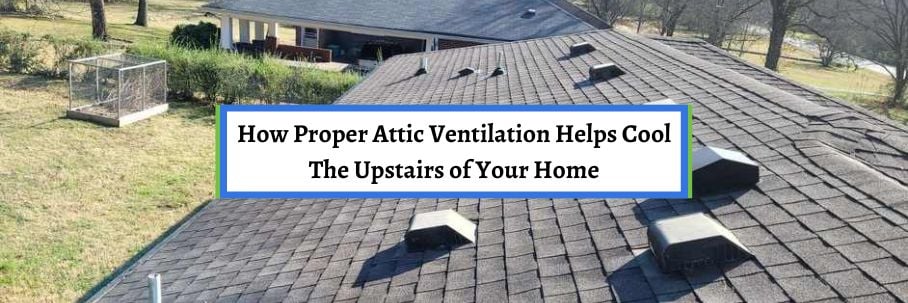
This past week I got a call from a homeowner whose upstairs wouldn't cool down no matter how much their AC unit was running. When I got there, I didn’t even need to get on the roof or go inside to see their home didn't have proper attic ventilation.
Not only is their upstairs impossible to cool down, but the trapped hot air in the attic literally burned up the roof system. And now, the whole roof has to be replaced.
The worst part is the homeowner just got the roof installed two years ago. Unfortunately, this means the roofing company they hired cut corners by not adding enough ventilation.
For over 30 years, Bill Ragan Roofing has helped homeowners understand how important their attic ventilation system is to their roof and home. I don't want the above scenario to happen to you, so let's break it down.
By the end of this article, you'll have answers to the following questions:
- What is attic ventilation?
- Why is proper attic ventilation important in the summer?
- Why is proper attic ventilation important in the winter?
- What are the two types of attic ventilation systems?
What is attic ventilation?
Simply put, your attic's ventilation system allows your home to breathe. Its job is to pull fresh air into your attic through intake vents while pushing the trapped air through exhaust vents.
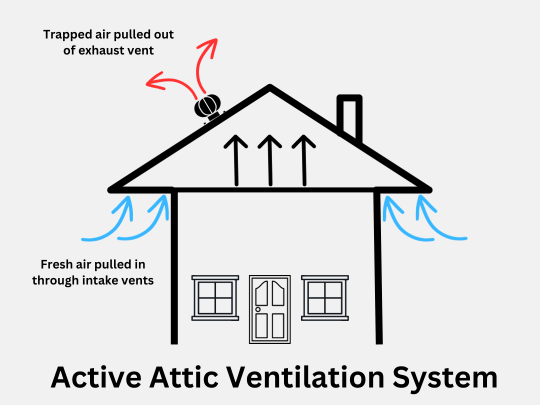
The intake vents are located at the lower part of your roof called the eaves or soffits, while exhaust vents are physically on your roof (I'll talk about the types in a minute). All attics need a balanced ventilation system to ensure there's an equal amount amount of air coming in and out.
Without adequate ventilation, your roof will fail prematurely, material warranties are voided, and insurance will deny any roof damage claims. Just know that the amount of ventilation your attic needs is different than other homes in your neighborhood.
If you stick around until the end, you'll be taken to another article that helps you determine how much ventilation your attic needs.
Why is proper attic ventilation important?
After learning what attic ventilation is and how it works, you're ready to how affects your roof and home during the changing seasons. Let's get to why proper attic ventilation is important during the summer and winter months.
Why is proper attic ventilation important in the summer?
Without proper ventilation, your attic gets very hot during the summer months. If the temperature outside is 90°F, the temperature in your attic can get as high as 170˚F.
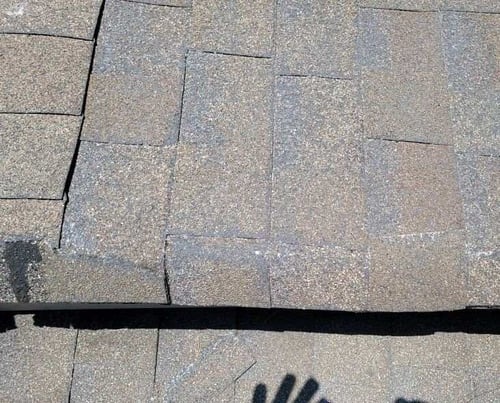
With nowhere to go, this trapped hot air literally burns your roof up, causing your asphalt shingles to crack, curl, and become brittle. However, that's just the roof part of the equation.
If the temperature inside your attic is 170˚F, the floor of your attic can be as high as 140˚F. This leads to the temperature in your home's upstairs rooms reaching a point where it's uncomfortable during the day.
Not only does this mean you can't enjoy parts of your home until the sun goes down, but your AC has to work harder to keep your home cool. With your AC working harder and running more, your monthly energy bills increase.
Why is proper attic ventilation important in the winter?
While improper attic ventilation is apparent during the summer, it's just as damaging in the winter. During the cold months, heat and moisture from the home’s interior travel into the cold attic, causing condensation to form on the underside of your roof's decking.
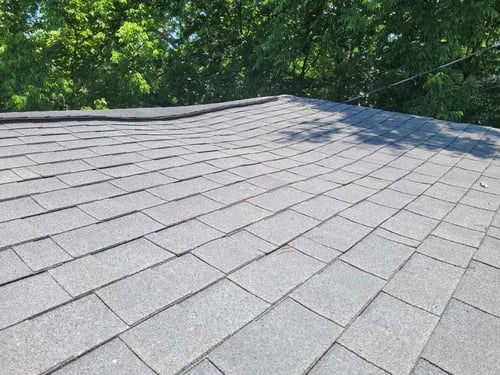
As the decking holds onto the moisture, it swells, becomes wavy, and rots the wood. Not only does it give your roof a wavy look, but the decking loses its ability to hold the nails and load-bearing capacity.
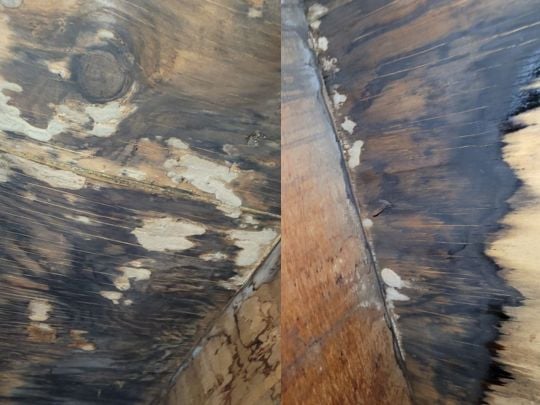 (Rotten wood on bottom of roof decking in an attic)
(Rotten wood on bottom of roof decking in an attic)
This can lead to serious structural damage if it goes unnoticed. There's also a potential health hazard when mold and mildew are allowed to thrive in a moist environment.
Plus, all the extra moisture rots wood, which is perfect for insects like termites.
What are the two types of attic ventilation systems?
There are two types of attic ventilation systems: active and passive. While I prefer active ventilation, both systems work as long as you have the right number of vents for the attic space.
Now, let's look at the two attic ventilation systems and the types of roof vents.
Active attic ventilation system
Active ventilation works by creating a drawing effect when the intake vents pull fresh air from outside while actively pushing the air in your attic out through the exhaust vents. This system and its accompanying vents actively work to ensure the air in your attic is moved in and out regularly.
The four most common types of active roof vents are turbine, power, ridge with a baffle, and solar-powered vents.
Turbine vents
Turbine vents (also known as whirly birds) use a drawing effect through convection (heat rising) to move the air in your attic around even when there is no wind.
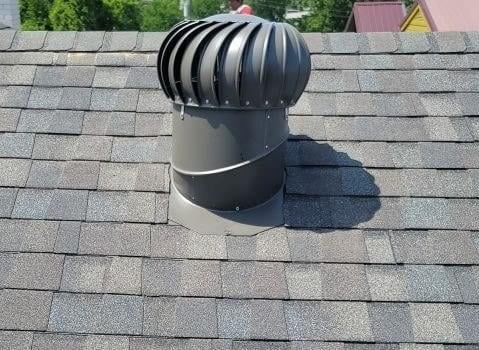
As long as it's installed properly, the air in your attic is moved around 10-12 times per hour. Because it's open-aired to the attic, there's a misconception that rain, snow, and insects can enter your home through the vent slats.
However, turbine vents are designed to prevent this from happening unless it's damaged.
Power vents
Power vents are circular-shaped with very low profiles installed near the ridge of a roof. They get the name "power" because they use electricity to actively pull the air out of the attic.
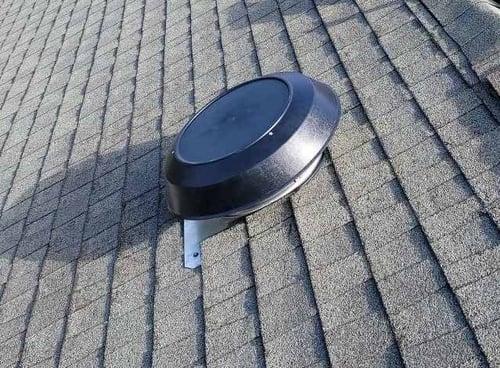
Just know that you should run a humidistat if you use a power vent in the winter. This helps prevent humidity build up and condensation in your attic.
Solar-powered vents
Solar powered vents are pretty much power vents, except they use the sun as their power source.
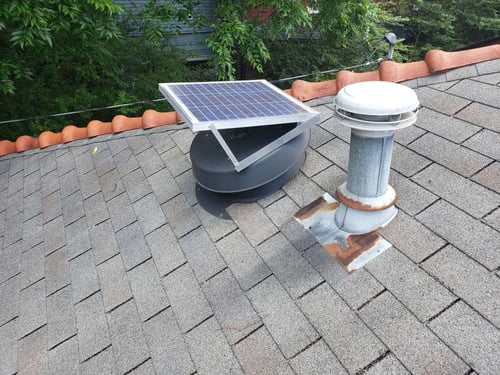
They sound great from an energy-saving standpoint but turn off when the solar powered battery is charging. So, while the battery is recharging, you may wind up with your air conditioner running more.
Ridge vents with a baffle
Ridge vents are cut into the ridge and run the length of a roof. An active ridge vent has a baffle (chutes that provide a channel for air to flow) to help move the air through your attic.
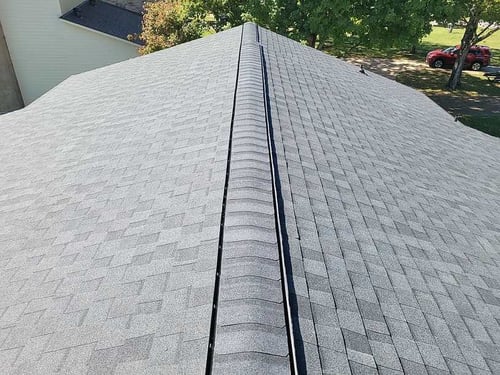
This is a popular roof vent because it isn't noticeable from the ground. But while they're extremely popular, insects, debris, rain, and snow can enter the attic if it doesn't have the baffle.
Passive attic ventilation system
Passive ventilation uses natural forces such as wind and convection to move the air in and out of your attic. The great thing is this system has no moving parts, creates no noise, and is virtually-maintenance free.
However, it isn't as efficient as active ventilation. There are three common types of passive roof vents: static, ridge without a baffle, and gable end.
Static vents
Static vents (also called turtle and box) allow air to escape the attic through the convection method. So, the air will only be pushed out as the hot air rises in the attic.
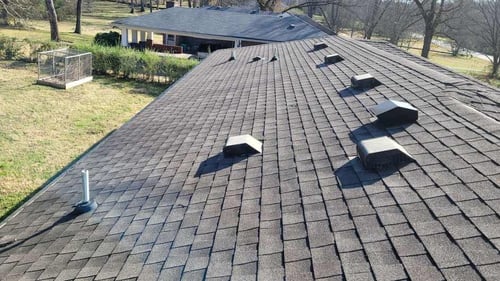
Just know that bigger attic spaces require a good amount of static vents on the roof (see above).
Ridge vents without a baffle
Just like the active version, a passive ridge vent is cut into the ridge and runs the length of the roof. But without a baffle, there's no active channel for the air to flow out of your attic, which makes it a passive vent.
And remember, ridge vents without a baffle can allow debris, rain, snow, and insects to enter your attic.
Gable end vents
A gable end vent is a wooden vent installed on the exterior wall of an attic below where the 2 slopes of a roof meet.
This vent relies on the wind coming from the outside to move the air in and out of your attic.
How much attic ventilation do you need?
After reading this article, you now know what attic ventilation is, why it's important, and two types of systems plus their vents. Unfortunately, inadequate attic ventilation is way too common in the United States.
In fact, it's one of the leading causes of premature roof failure. But as long as you hire a reputable roofing contractor, you shouldn't have to worry about this happening to you.
Now that you know the importance of attic ventilation, you're ready to learn how much ventilation your specific attic space needs. This not only helps you choose the right type of roof vent, but it also keeps potential roofing contractors on their toes.
Check out How Much Attic Ventilation Do I Need to learn if your home is properly ventilated based on your attic's square footage and the number of vents on the roof.


